
Author: Tyler Connaghan
Tyler Connaghan is a guitarist, singer, producer, composer & engineer based in Los Angeles, California. Tyler has been playing the guitar since 2007. In between writing for guitar publications, he produces music for film and television. His favorite axe is his custom Pelham Blue Fender Stratocaster.
Expertise: music industry, producing, acoustic & electric guitars, songwriting
Bachelor of Science in Music Industry Studies, Music Industry

Editor: Edward Bond
Edward has been playing the guitar since 2002. So Edward has over 20 years of experience as a guitarist, has authored 15 guitar books, has written for renowned music blogs, and spent a decade teaching music. He began merging his passion for writing and music in 2020 and has written for big guitar websites such as Guitar Head Publishing and KillerGuitarRigs.com.
Originally from Seattle, Edward moved to Norway in 2021 for a master’s in music. He’s studied at the Jazz Institute Berlin and Conservatorium van Amsterdam, and currently resides in Trondheim. His education includes a European Jazz Master’s, a diploma in Film and Game Scoring from Sofia, and a Bachelor’s in Jazz from University of Oregon.
Edward has played in numerous bands and currently, Edward works on his own project Starship Infinity

Check Today’s Price on
Imagine Having The Technique, Gear, and Sound of The GOATS… But Don’t just imagine. Find out.
Joe Satriani
Main Band
Solo Artist
Main Guitar
Ibanez Joe Satriani Signature JS2480
Joe Satriani
| Uniqueness | (4.5) |
| Accuracy | (5.0) |
| Speed | (5.0) |
| Right Hand | (5.0) |
| Techniques | (5.0) |
| Versatility | (3.5) |
| Performance | (4.5) |
| Overall Lead | (5.0) |
| Overall Rhythm | (4.5) |
Tommy Emmanuel
Main Band
Solo Artist
Main Guitar
Maton TE Personal
Tommy Emmanuel
| Uniqueness | (3.5) |
| Accuracy | (4.5) |
| Speed | (5.0) |
| Right Hand | (5.0) |
| Techniques | (5.0) |
| Versatility | (4.0) |
| Performance | (4.0) |
| Overall Lead | (5.0) |
| Overall Rhythm | (5.0) |
Steve Vai
Main Band
Solo Artist
Main Guitar
Ibanez Steve Vai JEM77
Steve Vai
| Uniqueness | (4.5) |
| Accuracy | (5.0) |
| Speed | (5.0) |
| Right Hand | (4.5) |
| Techniques | (5.0) |
| Versatility | (3.0) |
| Performance | (4.5) |
| Overall Lead | (5.0) |
| Overall Rhythm | (4.5) |
The Next Best:
Runner-up Electric Guitar Under $500 –
Squier Classic Vibe 50s Stratocaster
Check Today’s Price on
Summary
Pros:
- Vintage Style: You get all the best characteristics of a Stratocaster wrapped up in vintage-style colors and hardware.
- Tonal Versatility: With three single-coil pickups and a five-way selector switch, the range of tones you can get out of this thing is incredible.
- Comfortable: One of my favorite necks to play is the standard Fender C-shape neck.
Cons:
- Tuning Stability: I’ve found that these guitars offer less tuning stability than their Telecaster counterparts due to the vintage-style trem bridges.
Who is this guitar for?
I’d highly recommend the Classic Vibe 50s Stratocaster for beginner or intermediate players who want a tonally versatile guitar with a vintage look.
Best For Metal Under $500 –
Jackson Dinky Arch Top JS32 DKA
Check Today’s Price on
Summary
Pros:
- Playability: Jackson guitars have long been known for their fast, shred-friendly necks. The neck on the JS32 DKA is no exception.
- Personalized Aesthetic: With so many finishes, you can match your JS32 DKA to your unique style.
- Floyd Rose Bridge: If you want to incorporate vibrato and dive bombs into your playing, you’ll be happy to know that this model comes with a Jackson-branded Floyd Rose tremolo system.
Cons:
- Complicated Setup: If you’re a complete beginner, changing the strings and re-tuning with the Floyd Rose system can be a huge pain.
Who is this guitar for?
Whether you’re a hard rocker, prog rock player, or metalhead shredder, the Jackson JS32 DKA is one of the most versatile and solid-sounding budget-friendly electric guitars on the market.
Best For Jazz –
Gretsch G2622 Streamliner
Check Today’s Price on
Summary
Pros:
- Craftsmanship: From the durable body to the stock hardware, this guitar represents Gretsch craftsmanship beautifully, at an affordable price.
- Very Playable: The neck is super comfortable and perfect for playing without fatigue.
- Solid Tone: I can’t think of a better guitar to get that semi-hollowbody sound for the price.
Cons:
- Cheap Knobs: The volume knobs have a cheap plastic feeling and are unbalanced.
Who is this guitar for?
I’d recommend the Gretsch G2622 Streamliner to any jazz, blues, or rockabilly players on a budget. You get that classic Gretsch sound without breaking the bank.
Best For Beginners –
Epiphone Les Paul Special Satin E1
Check Today’s Price on
Summary
Pros:
- No-Nonsense Design: With limited pickup switching options and dual tone knobs, it’s a simple, easy-to-navigate design perfect for beginners.
- Lightweight Body: The poplar body is super light, adding to the resonant tone and making it easier to play for hours.
- Killer Humbucker Tone: You get the same crunchy warmth you’d expect from a Les Paul with the open humbuckers.
Cons:
- Quality Control Issues: With uber-cheap guitars, you often have to deal with quality control issues, meaning you’ll likely need to pay for a decent setup when you get it.
Who is this guitar for?
The Epiphone Les Paul Special Satin E1 is one of the best beginner electric guitars out there and one of my top electric guitar recommendations for budget-conscious players getting their feet wet in electric guitars.
Compare the Key Specs
| Model | Price Range ($-$$$$) | Body Style | Neck | Fretboard | Bodywoods | Nut Width | Nut Material | Bridge | Scale-Length | Pickups | Controls | Our Rating |
|---|---|---|---|---|---|---|---|---|---|---|---|---|
| Best Overall – Squier Classic Vibe 50s Telecaster | $$ | Solidbody ’50s Telecaster | Bolt-On Maple | 21, Narrow Tall on Maple Fingerboard | Pine | 1.650″ | Bone | 3-Saddle Vintage-Style Strings-through Body with Chrome Barrel Saddles | 25.5″ | 2 * Fender Designed Alnico Single-coil | 1 x master volume 1 x master tone 3-way toggle pickup switch | 4.7 |
| Runner-up – Squier Classic Vibe 50s Stratocaster | $$ | Solidbody ’50s Stratocaster | Maple Bolt-on | 21, Narrow Tall on Maple Fingerboard | Nato | 1.650″ | Bone | Vintage-style Synchronized Tremolo | 25.5″ | 3 * Fender Designed AlNiCo Single-coil | 1 x master volume 2 x tone 5-way blade pickup switch | 3.9 |
| Best For Metal – Jackson Dinky Arch Top JS32 DKA | $$ | Solidbody Dinky Arch Top | Bolt-on Maple | 24, Jumbo on Amaranth Fingerboard | Poplar | 1.6875″ | Locking | Jackson Licensed Floyd Rose Locking Tremolo | 25.5″ | 2 * Jackson High-output Humbucker | 1 x master volume 1 x master tone 3-way blade pickup switch | 4.6 |
| Best For Jazz – Gretsch G2622 Streamliner | $$ | Semi-hollowbody G2622T Streamliner | Nato Set Neck | 22 on Laurel Fingerboard | Laminated Maple | 1.6875″ | Bone | Anchored adjusto-matic with Bigsby string-thru vibrato tailpiece | 24.75″ | 2 * Broad’Tron BT-3S Humbucker | 2 x volume 1 x master volume 1 x master tone 3-way toggle pickup switch | 4.9 |
| Best For Beginners – Epiphone Les Paul Special Satin E1 | $ | Solidbody Les Paul Special E1 | Mahogany Bolt-on | 22, Medium Jumbo on Rosewood | Poplar | 1.6875″ | PVC | Tune-O-Matic Bridge with Stopbar Tailpiece | 24.75″ | 650R Humbucker 700T Humbucker | 1 x master volume 1 x master tone 3-way toggle pickup switch | 4.4 |
Compare The Pickups:
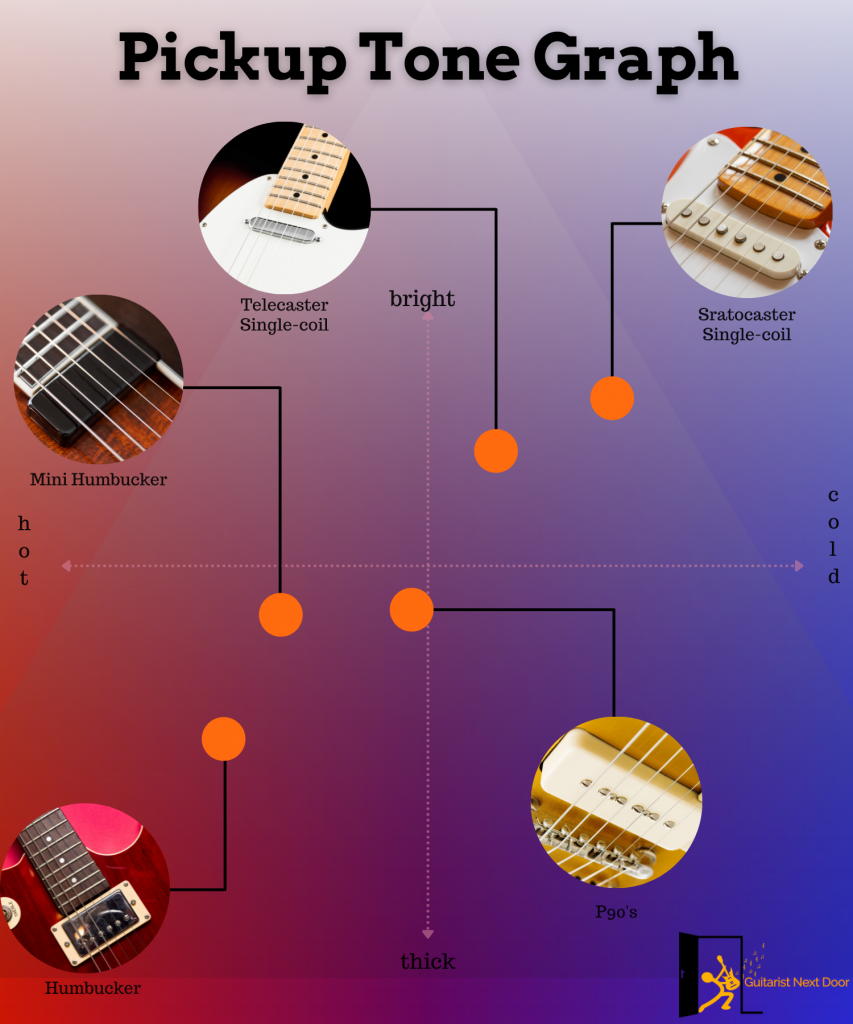
Pickups
Neck: Fender Designed Alnico Single-coil
Bridge: Fender Designed Alnico Single-coil
Pickups
Neck: Fender Designed AlNiCo Single-coil
Middle: Fender Designed AlNiCo Single-coil
Bridge: Fender Designed AlNiCo Single-coil
Pickups
Neck: Jackson High-output Humbucker
Bridge: Jackson High-output Humbucker
Pickups
Neck: Broad’Tron BT-3S Humbucker
Bridge: Broad’Tron BT-3S Humbucker
Pickups
Neck: 650R Humbucker
Bridge: 700T Humbucker
Learn more about electric guitar pickup types here.
Buying a “budget-friendly” guitar no longer means you need to skimp out on quality. While $500 won’t send you home with the newest, top-of-the-line Fender American Ultra Stratocaster or a vintage Gibson Les Paul, you might be surprised at the level of craftsmanship and playability you can get for less than $500.
I’ve been a massive proponent of budget-friendly guitars for years. Beyond the fact that they’re great for gigging (I can’t even begin to tell you the number of awesome gigs I’ve played with my Squier Tele Thinline), many of them have a completely unique sound that you might not be able to recreate with something more expensive.
Whatever the reason you’re looking for a new guitar, I’m here to help with a curated list of the best guitars under $500.
Our Reviews of The Top 5
Keep These 3 Key Things In Mind When Choosing an Inexpensive Electric Guitar:
- Budget.
- Style.
- Playability.
How Did We Choose These Guitars?
With so many top-notch guitars under $500, putting this list together took a lot of work. So, to better narrow things down, I thought of a few key things to look for:
- First, I wanted to ensure that I was staying under the $500 budget and still getting a guitar from a major guitar manufacturer. With major guitar manufacturers, you get better reliability under that price point and larger communities of players that can provide modification info if you choose to make any upgrades in the future.
- The second thing I wanted to look at was style. The list offers budget-friendly electric guitars that touch on various playing styles, from solid-body, high-gain-friendly electric guitars, perfect for metal and hard rock, to mellower, vintage-style hollowbodies better suited to jazz or old-school blues.
- Lastly, I thought of playability. Most of you looking at this list will likely be beginners, so knowing that these guitars are easy to play, offer a decent level of tuning stability, and aren’t laced up with complicated electronics and hardware will make the choosing process less stressful.
Most electric guitars we recommend are run through tests like these:
- We check electronics (Basic measurements with multimeter, resistance, etc.)
- We inspect the guitar carefully to get a good idea of the finish and built quality of the guitar.
- We inspect the fretwork and edges of the fretboard to make sure there are no sharp edges.
- We run the guitar usually through BOSS Katana 50 MK2 and test clean, crunch, and distorted tones with lead and rhythm playing.
- We use different playing styles to get a good feel for the playability. We use fingerpicking, sweep picking, riffs from different genres, shredding, tapping, chord playing, etc.
- We test all the possible pickup combinations and use different Volume and Tone settings from the guitar.
- We measure and weight the guitar.
- We test the guitar with drop tunings.
Learn more about GND’s testing and reviewing processes here.
Best Overall Electric Guitar Under $500 – Squier Classic Vibe 50s Telecaster

Specs
| Body Style | Solidbody ’50s Telecaster |
| Body Wood | Pine |
| Neck | Bolt-On Maple |
| Neck Shape | C |
| Neck Radius | 9.5″ |
| Fretboard | 21, Narrow Tall on Maple Fingerboard |
| Nut | Bone |
| Nut Width | 1.650″ |
| Pickups | 2 * Fender Designed Alnico Single-coil |
| Controls | 1 x master volume 1 x master tone 3-way toggle pickup switch |
| Scale-Length | 25.5″ |
| Bridge | 3-Saddle Vintage-Style Strings-through Body with Chrome Barrel Saddles |
| Tuners | Vintage-style |
Squier is a budget-friendly electric guitar brand under the umbrella of Fender, one of the most important guitar manufacturers on Earth. Even though Squier gets a bad rep from professional musicians, they make some of the best electric guitars for beginners.
The guitar is a solid pine body with a classic 50s-style finish. The iconic Tele twang you’d get from a traditional Fender Telecaster can be found here, thanks to the Fender alnico single-coil pickups.
The playability is incredibly smooth, much of which is thanks to the C-shaped maple neck. I’ve always been a fan of maple necks on Teles. I feel like they accentuate that already bright, snappy, and twangy tone that the guitars themselves are known for.
Overall, the Squier Classic Vibe 50s Telecaster is most likely as close as you’ll get to the tone and playability of a true Fender Telecaster without cashing out big. In my opinion, it’s the best electric guitar under $500.
Summary
| Pros | Cons |
|---|---|
| Vintage Design: Matches the iconic design of the 50s Telecaster beautifully. | Stock Pickups: There’s a slight lack of warmth and fullness that you get with the stock pickups compared to those on a standard Fender Telecaster. |
| Solid Construction: Squier has come far with its construction quality over the years. With the Classic Vibe Series, it shows. | |
| Comfortable Playability: I absolutely love the C-shaped neck for playing long hours at a time. |
What others are saying:
“I’m a beginner at guitar and I wanted a decent guitar to start. I absolutely love my Telecaster. This CV 50’s Tele is the best. I love the “Twangy” sound of it and it’s perfect for the older country style (Bakersfield sound). I play mine everyday for at least 3-4 hrs.”
- Chris Pendergrass, Sweetwater customer
Who is this guitar for?
This is one of the best electric guitars for blues, country, and rock players who want access to that classic Tele sound without breaking the bank.
Who is this guitar NOT for?
I wouldn’t recommend it for those who play metal or high-gain amps and pedals. The Classic Vibe isn’t well-suited to that style.
Check Today’s Price on:
Runner-up Electric Guitar Under $500 – Squier Classic Vibe 50s Stratocaster

Specs
| Body Style | Solidbody ’50s Stratocaster |
| Body Wood | Nato |
| Neck | Maple Bolt-on |
| Neck Shape | C |
| Neck Radius | 9.5″ |
| Fretboard | 21, Narrow Tall on Maple Fingerboard |
| Nut | Bone |
| Nut Width | 1.650″ |
| Pickups | 3 * Fender Designed AlNiCo Single-coil |
| Controls | 1 x master volume 2 x tone 5-way blade pickup switch |
| Scale-Length | 25.5″ |
| Bridge | Vintage-style Synchronized Tremolo |
| Tuners | Vintage Style |
All the same quality components and craftsmanship you’d expect to find on the Squier Classic Vibe 50s Telecaster can also be found on its cousin, the Squier Classic Vibe 50s Stratocaster. The main difference is that this iteration delivers the sound, design, and playability of a traditional Fender Stratocaster without the bank-breaking price.
The neck uses a smooth, C-shape profile for buttery playability, while the pickups sound much like what you’d expect on a traditional Strat. It sounds like these have a better output than other Strats in the Squier lineup.
Compared to a Tele, you get much more tonal versatility from a Stratocaster, thanks to the three single-coil pickups and the five-way pickup switch, allowing you to experiment with a wide range of tones.
As the cherry on top, the guitar is outfitted with a vintage synchronized tremolo, perfect for adding a bit of vibrato to your playing. With a gorgeous, vintage look and versatile tonality, it’s one of the best electric guitars for intermediate players in this price range.
Summary
| Pros | Cons |
|---|---|
| Vintage Style: You get all the best characteristics of a Stratocaster wrapped up in vintage-style colors and hardware. | Tuning Stability: I’ve found that these guitars offer less tuning stability than their Telecaster counterparts due to the vintage-style trem bridges. |
| Tonal Versatility: With three single-coil pickups and a five-way selector switch, the range of tones you can get out of this thing is incredible. | |
| Comfortable: One of my favorite necks to play is the standard Fender C-shape neck. |
What others are saying:
“My first ever Stratocaster, I put a different color pickguard on is all, it plays great, pickups sound amazing clean, neck is wonderful, tuners top notch. No complaints from Me up in Butte, MT.”
- John Willard, Sweetwater customer
Who is this guitar for?
I’d highly recommend the Classic Vibe 50s Stratocaster for beginner or intermediate players who want a tonally versatile guitar with a vintage look.
Who is this guitar NOT for?
Advanced players might find the lack of modern features, such as high-end pickups and locking tuners, a bit troublesome.
Check Today’s Price on:
Best For Metal Under $500 – Jackson Dinky Arch Top JS32 DKA

Specs
| Body Style | Solidbody Dinky Arch Top |
| Body Wood | Poplar |
| Neck | Bolt-on Maple |
| Neck Shape | Speed |
| Neck Radius | 12″-16″ compound |
| Fretboard | 24, Jumbo on Amaranth Fingerboard |
| Nut | Locking |
| Nut Width | 1.6875″ |
| Pickups | 2 * Jackson High-output Humbucker |
| Controls | 1 x master volume 1 x master tone 3-way blade pickup switch |
| Scale-Length | 25.5″ |
| Bridge | Jackson Licensed Floyd Rose Locking Tremolo |
| Tuners | Jackson Sealed Die-cast |
A few years back, I played my very first Jackson guitar. I’ll be the first to say that I’ve never been a huge metal player. But, there was something about tuning this baby down to drop D and wailing away that I had never experienced with a Jackson model. From then on, I got it.
Jackson has long had a place in the metal community for its hard rock guitar designs, thin, shred-friendly necks, and high-output humbuckers that scream to be played through an overdriven amp.
The company made a huge leap forward with this budget-friendly model, offering the tone, style, and bells and whistles you expect from a higher-end Jackson model.
The guitar has stable die-cast tuners, a Floyd-Rose double-locking tremolo bridge, and 24 jumbo frets for an extended range. The maple speed neck feels like butter in your hands, while the Jackson humbuckers deliver a clear yet powerful tone.
It might be the best metal guitar for under $500.
Summary
| Pros | Cons |
|---|---|
| Playability: Jackson guitars have long been known for their fast, shred-friendly necks. The neck on the JS32 DKA is no exception. | Complicated Setup: If you’re a complete beginner, changing the strings and re-tuning with the Floyd Rose system can be a huge pain. |
| Personalized Aesthetic: With so many finishes, you can match your JS32 DKA to your unique style. | |
| Floyd Rose Bridge: If you want to incorporate vibrato and dive bombs into your playing, you’ll be happy to know that this model comes with a Jackson-branded Floyd Rose tremolo system. |
What others are saying:
“Awesome playability, great sound, I play every day. This guitar was perfect for me and it didn’t break the bank. It looks good, sounds great & feels awesome.”
- KHOUSE, Sweetwater customer
Who is this guitar for?
Whether you’re a hard rocker, prog rock player, or metalhead shredder, the Jackson JS32 DKA is one of the most versatile and solid-sounding budget-friendly electric guitars on the market.
Who is this guitar NOT for?
If you’re a traditional guitarist looking for a simple vintage tone, you probably won’t find what you want with the Jackson JS32 DKA.
Check Today’s Price on:
Best For Jazz – Gretsch G2622 Streamliner

Specs
| Body Style | Semi-hollowbody G2622T Streamliner |
| Body Wood | Laminated Maple |
| Neck | Nato Set Neck |
| Neck Shape | Soft C |
| Neck Radius | 12″ |
| Fretboard | 22 on Laurel Fingerboard |
| Nut | Bone |
| Nut Width | 1.6875″ |
| Pickups | 2 * Broad’Tron BT-3S Humbucker |
| Controls | 2 x volume 1 x master volume 1 x master tone 3-way toggle pickup switch |
| Scale-Length | 24.75″ |
| Bridge | Anchored adjusto-matic with Bigsby string-thru vibrato tailpiece |
| Tuners | Die-cast, Closed Gear |
While Gretsch isn’t exactly known for manufacturing cheap guitars, they have a budget-friendly Streamliner series offering plenty of value for the money.
The first time I picked up and played a Gretsch G2622 Streamliner, I thought I was playing a much more expensive guitar. For starters, the body is made of solid wood with a laminated flame top rather than fully laminated, which, within the price range, you don’t often see.
I also love the prominent cut-away design, which provides better access to the high registers and optimizes overall range accessibility.
Beyond the stellar vintage look that Gretsch guitars are so good at delivering, every element impacts the tone and playability. The rosewood fingerboard on the maple neck gives the guitar that classic, jazzy warmth, while the comfortable neck with standard medium jumbo frets makes it easy to play for hours at a time.
While you don’t get the Bigsby bridge, which I usually love to see on Gretsch guitars, the Tune-O-Matic bridge does add to the guitar’s tuning stability.
Summary
| Pros | Cons |
|---|---|
| Craftsmanship: From the durable body to the stock hardware, this guitar represents Gretsch craftsmanship beautifully, at an affordable price. | Cheap Knobs: The volume knobs have a cheap plastic feeling and are unbalanced. |
| Very Playable: The neck is super comfortable and perfect for playing without fatigue. | |
| Solid Tone: I can’t think of a better guitar to get that semi-hollowbody sound for the price. |
What others are saying:
“This is the first Gretsch I’ve purchased but I have owned and played many guitars over the years. I also own an Ibanez hollowbody and this guitar is more comfortable and has better playability and a faster neck which surprised me.”
- Amy (Adorama)
Who is this guitar for?
I’d recommend the Gretsch G2622 Streamliner to any jazz, blues, or rockabilly players on a budget. You get that classic Gretsch sound without breaking the bank.
Who is this guitar NOT for?
With its semi-hollowbody design, I wouldn’t recommend it to metal or heavy rock players or players who want a bit more tonal versatility.
Check Today’s Price on:
Best For Beginners – Epiphone Les Paul Special Satin E1

Specs
| Body Style | Solidbody Les Paul Special E1 |
| Body Wood | Poplar |
| Neck | Mahogany Bolt-on |
| Neck Shape | ’60s Slim Taper D |
| Neck Radius | 14″ |
| Fretboard | 22, Medium Jumbo on Rosewood |
| Nut | PVC |
| Nut Width | 1.6875″ |
| Pickups | 650R Humbucker 700T Humbucker |
| Controls | 1 x master volume 1 x master tone 3-way toggle pickup switch |
| Scale-Length | 24.75″ |
| Bridge | Tune-O-Matic Adjustable Bridge with Stopbar Tailpiece |
| Tuners | Premium Closed Gear, 14:1 ratio |
The Epiphone Les Paul Special is among the most affordable guitars in the Epiphone lineup. Yet, even with its insanely low sticker price, the manufacturers were able to deliver a true piece of work for those who have always been drawn to the Gibson classic rock sound.
You get a fat, warm tone, thanks to the open-coil humbuckers, and a uniquely resonant sound, thanks to the lightweight poplar body, which is excellent for playing live for hours. You get a rosewood fretboard and mahogany neck to add warmth and sustain.
The team at Epiphone did an excellent job with the broken-in vintage-worn finish look, as it makes the guitar look far more expensive than it is. Compared to a Strat, the three-way selector switch doesn’t provide as much tonal versatility. Though for beginners, it’s much simpler to navigate, making the learning process far less overwhelming.
Summary
| Pros | Cons |
|---|---|
| No-Nonsense Design: With limited pickup switching options and dual tone knobs, it’s a simple, easy-to-navigate design perfect for beginners. | Quality Control Issues: With uber-cheap guitars, you often have to deal with quality control issues, meaning you’ll likely need to pay for a decent setup when you get it. |
| Lightweight Body: The poplar body is super light, adding to the resonant tone and making it easier to play for hours. | |
| Killer Humbucker Tone: You get the same crunchy warmth you’d expect from a Les Paul with the open humbuckers. |
What others are saying:
“As a beginner, this is a great option for a Les Paul. After you’ve played for a while and would consider yourself to be more “intermediate”, you may want to upgrade to a higher-end Epiphone, but as someone who’s just starting out, this guitar has a lot of value.”
- John, Sweetwater customer
Who is this guitar for?
The Epiphone Les Paul Special Satin E1 is one of the best beginner electric guitars out there and one of my top electric guitar recommendations for budget-conscious players getting their feet wet in electric guitars.
Who is this guitar NOT for?
I would not recommend this guitar for professional players or those looking for more traditional Les Paul features, such as high-end electronics or a carved top.
Check Today’s Price on:
Runner-Ups That Just Missed The Top 5
| Best for Country | Squier Classic Vibe 70s Telecaster Thinline |
| Best for P90 Sound | Epiphone Coronet |
| Best Ibanez Guitar | Ibanez S521 |
| Best Left-Handed Guitar | Ibanez AZES40 |
| Best Hollowbody | Ibanez Artcore AS73 |
Buyer’s Guide
What Can You Expect From Electric Guitars Under $500?
These days, you can actually expect quite a bit from a budget-friendly guitar under $500. I would go as far as saying that it’s pretty tricky to find a genuinely terrible guitar.
Most major electric guitar brands have high-end, technologically advanced manufacturing plants, making it much easier to churn out cheaper six strings. Of course, you won’t get the same handcrafted touch that you’d get from a high-end, $2,000+ axe. But for most people, that’s unnecessary anyway.
For $500, you can expect a solid build quality that holds up well for most regular players, simple, run-of-the-mill hardware and electronics setups, and a fairly versatile range of options.
How to Choose The Right Electric Guitar Under $500 For You?
Manufacturer
First, I’d recommend you start looking at electric guitar manufacturers that offer high-quality instruments under $500. As I said before, I think it’s a good idea to start with well-known, reputable brands, as they not only have histories producing quality instruments, but also have large communities of guitarists that can give you more insight into each guitar before you purchase.
Here are a few of the best electric guitar brands you can start with:
- Squier (by Fender).
- Epiphone (by Gibson).
- Ibanez.
- Gretsch.
- Jackson.
- Yamaha.
Design
Once you find a brand that you like, you’ll want to start considering the design of the guitar you want, as it’ll determine the tone and feel you get from your guitar.
Do you want a warm, dark sound? How about a clear, bell-like tone? Something hollow and resonant?
The best way to determine what kind of design suits you best is by looking at what some of your favorite guitarists use. For example, if you’re a Slash fan or someone into heavy rock or metal, you might consider going the Les Paul-style route and getting an electric guitar with humbuckers.
On the other hand, if you’re someone who digs the crispy, clean funk of guitarists like Nile Rodgers, you might consider going the Stratocaster-style route.
There’s a big difference between hollowbody and solid-body guitars as well.
Of course, there are hundreds of other guitarists with unique styles and guitars, so do some research and see if any of the above choices align with the music you see yourself making.
Construction and Materials
While you shouldn’t expect top-of-the-line materials or build quality in a guitar under $500, there are certainly options that you can look for, depending on your preferences.
Beyond the overall design, which I touched on a bit in the above section, there are a few construction characteristics you might want to consider:
- Body: While many electric guitars utilize solid tonewood bodies, such as alder or mahogany, many budget-friendly guitars use cheaper laminate construction or inexpensive woods like poplar. While I don’t believe tonewood has a HUGE impact on electric guitar bodies and the way they sound, there are instances where your preferences might drive you one way or the other.
- Neck: The neck design can have a more significant impact on tone and playability. The difference between the bright, snappy tone of a maple neck and the warm, woody sustain of a mahogany neck is an excellent example of this impact.
- Fretboard: Lastly, you’ll want to look at the material the fretboard uses to determine if those tonal characteristics align with your style. Rosewood, for example, has a much mellower sound than maple.
Check out our Electric Guitar Body Shapes guide for more general construction style information.
Electronics
In terms of electronics, the thing you’ll want to concern yourself with most are the pickups.
You’ll often find yourself comparing two main types of pickups — single-coil vs. humbucker.
Single-coil pickups are great for a cleaner, janglier tone with a better dynamic range. However, they are also quite noisy, especially when played through high-gain amplifiers and pedals.
On the other hand, humbucker pickups are made of two single coils that cancel out the hum and interference you get with single-coil pickups. The design allows you to crank up the overdrive and gain and get a thick, heavy sound without worrying about unwanted noise.
However, compared to single-coil pickups, humbuckers often lack clarity.
The choice here depends on what music style you play and what kind of sound you ultimately want.
Neck Profile & Playability
You want your neck to feel smooth, straight, and playable when all is said and done. Your fingers should glide nicely along the fretboard as you play without feeling strained. Ensure the neck isn’t warped or bowed in any way, as this can be bad for your guitar’s intonation.
You have a couple of options regarding neck profile or neck shape. Those with smaller hands might be more comfortable with a slim C profile, while those looking for a chunkier, sturdier feel might look to vintage U-neck profiles.
Check out our guitar neck shape guide for a deeper dive into neck shapes and what you can expect!
Sound
The pickups and overall construction of the guitar you choose will have the most significant impact on the way it sounds. Again, I find it helpful to look at what your favorite guitarists are using and how they are playing to get a better idea of what to look for tonally.
You can also listen to video demos on YouTube to get familiar with the sound of a particular guitar. While some guitars offer versatile tones, others are better suited to specific tones. For example, a Gretsch Streamliner might be a killer option for an old-school jazz and blues electric guitar, though getting it to hold its own when playing high-gain metal might be tough.
Amplifier & Other Accessories Cost
Remember that when you buy an electric guitar, especially if it’s your first one, you might need to purchase additional accessories to play it.
A basic electric guitar rig includes an amplifier, cable, strap, and picks. It’ll likely include a gig bag or hard case for storage and transport. All of these elements should be part of your budget.
However, if you’re a complete beginner, I recommend looking at bundles. Most top guitar brands offer guitar, amp, and accessory bundles, providing a cost-effective way to get everything you need to start playing immediately.
How to Test
If you’re like me, you want to be able to play a guitar before you dive headfirst into a big financial decision. Of course, going to a local guitar shop and testing out guitars can be overwhelming if you don’t know what to look for.
So, how do we properly test a guitar?
First, I like to pick it up and play some of my go-to songs. At this point, it doesn’t even need to be plugged in. I want to ensure it feels comfortable in my hands, and I like how it looks.
Does the action feel too high or too low? Do I have easy access to the top frets? How does the neck profile fit in my hands? Is it staying in tune well?
Certain things, such as action and intonation, can be easily adjusted, though other things, such as neck design and fretboard material, are more permanent. Ensuring that you like the permanent characteristics is vital.
Lastly, plug it in and see how it sounds. Play the styles of music you like with your favorite amps and pedals and see how they gel with the guitar. Now, you can listen for clarity, warmth, sustain, output, and other important tonal qualities.
The best advice I can give you is to trust your ears when testing out different guitars. You’ll know when you feel that spark.
Should You Consider Buying Second-Hand Guitars Under $500?
The main thing to keep in mind when buying a used instrument is to do your research, find a reputable second hand purchasing platform (Reverb, Facebook Marketplace, etc.), inspect the guitar well, and ask the seller any necessary questions about its history and the reason they’re selling it. I’ve purchased several used instruments over the years and have never had a bad experience.
There are many benefits to buying used. You can save a lot of money, allowing you to stretch your $500 budget further. Secondly, you’ll most likely buy a guitar that’s already set up or upgraded. Third, you’ll get access to specific models that may not be available anymore.
Of course, there are drawbacks, too. The risk of buying something in poor condition or with hidden issues is much higher. If something goes awry, you won’t have a warranty unless you buy a pre-owned guitar from a major guitar outlet, such as Guitar Center or Sam Ash.
FAQs
What Are The Best Brands For Electric Guitars Under $500
Some of my favorite guitar brands that offer electric guitars for under $500 include:
- Squier
- Epiphone
- Ibanez
- Yamaha
- Gretsch
- Jackson
- Schecter
What Type Of Electric Guitar Is Best For Beginners?
There are many great electric guitars for beginners, though the one that will be best for you depends on your preferences. With that said, I often look for simplicity and playability above all else. Telecaster-style guitars are great for beginners, as they’re comfortable to play and use minimal pickup configurations, making them easier to navigate.
What Is The Best Stratocaster-Style Guitar Under $500?
The Squier Classic Vibe 50s Stratocaster is one of the best Stratocaster-style guitars for under $500.
What Is The Most Versatile Electric Guitar Under $500?
When it comes to versatility, the Squier Classic Vibe 50s Stratocaster takes the cake as well. With three single-coil pickups and a five-way pickup switch, the tonal possibilities are endless.
What Other Accessories Do I Need While Buying An Electric Guitar?
Though you’ll likely end up buying numerous accessories over the years to streamline or customize your playing style, including capos, pedals, straps, and cases, there are only a few things you absolutely need to play your electric guitar: an amplifier and a guitar cable.
Can I Upgrade My $500 Electric Guitar To Improve Its Performance?
Absolutely! I’ve upgraded several low-end guitars to make them sound better.
If you want to upgrade your guitar, you can install new pickups to match your style, replace the stock tuners with locking tuners for better stability, improve the sustain of the guitar with a bone nut instead of a plastic nut, or swap out the stock pots and wiring for clearer, low-noise performance.
Is It Better To Spend More On A Good Guitar Or A Good Amp?
As a beginner, investing in a good guitar is much better than investing in a good amp. While they both provide different levels of tone, versatility, and style, not to mention long-term investment, a great guitar will sound good when played through several mediums, from physical electric guitar amps to virtual amps to DI boxes.
Conclusion
There you have it, the best electric guitars under 500 dollars. I hope my electric guitar reviews have helped narrow down your buying decision.
Beyond the specific models, I believe the above brands make some of the best electric guitars for the money, so whether you’re looking for a twangy single-coil electric guitar that can provide you with those crispy country music clean tones or a thin neck, low action guitar that’s great for shredding, soloing, and delivering high-gain distorted tones, you’ll be able to find something affordable that suits your needs.



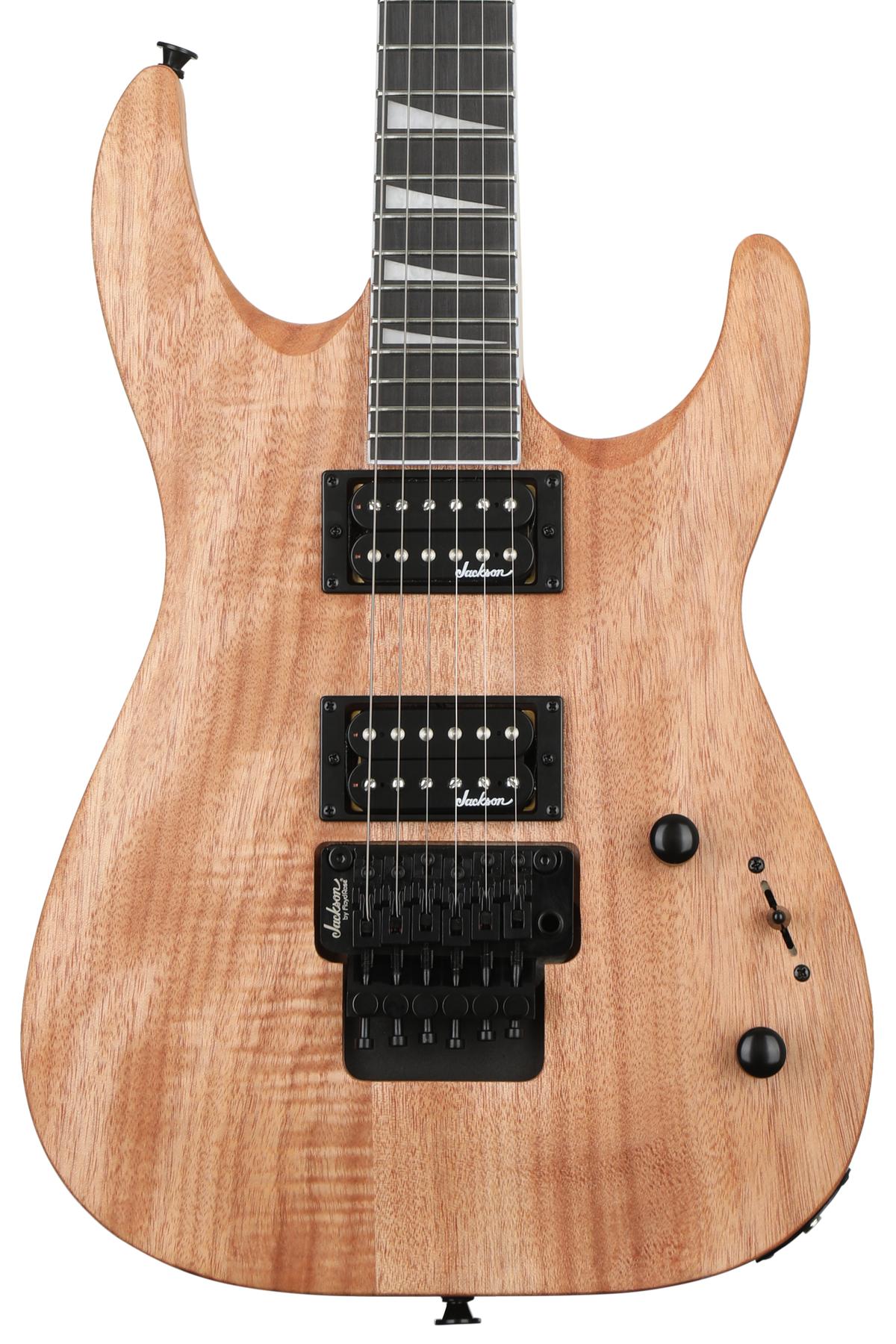
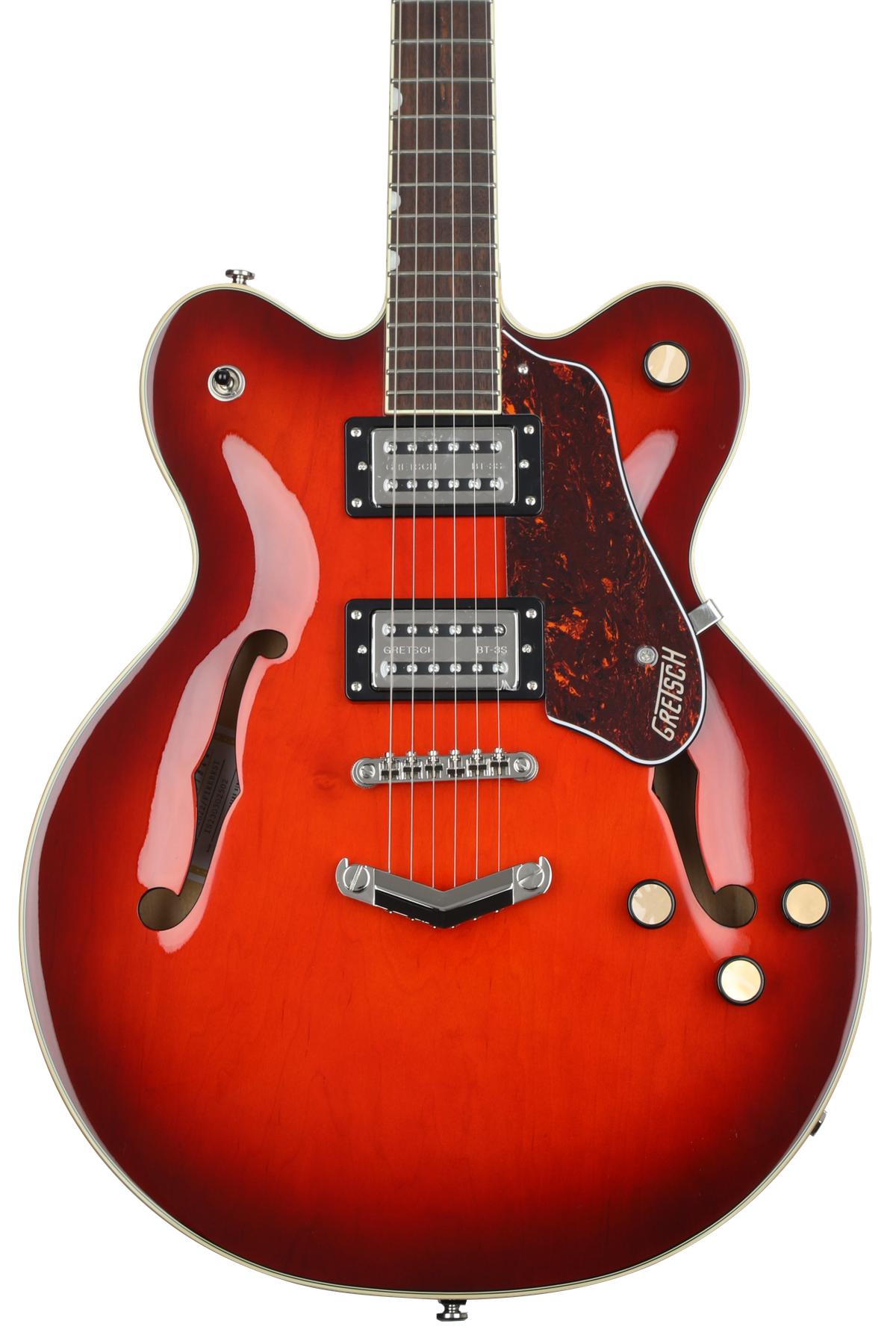
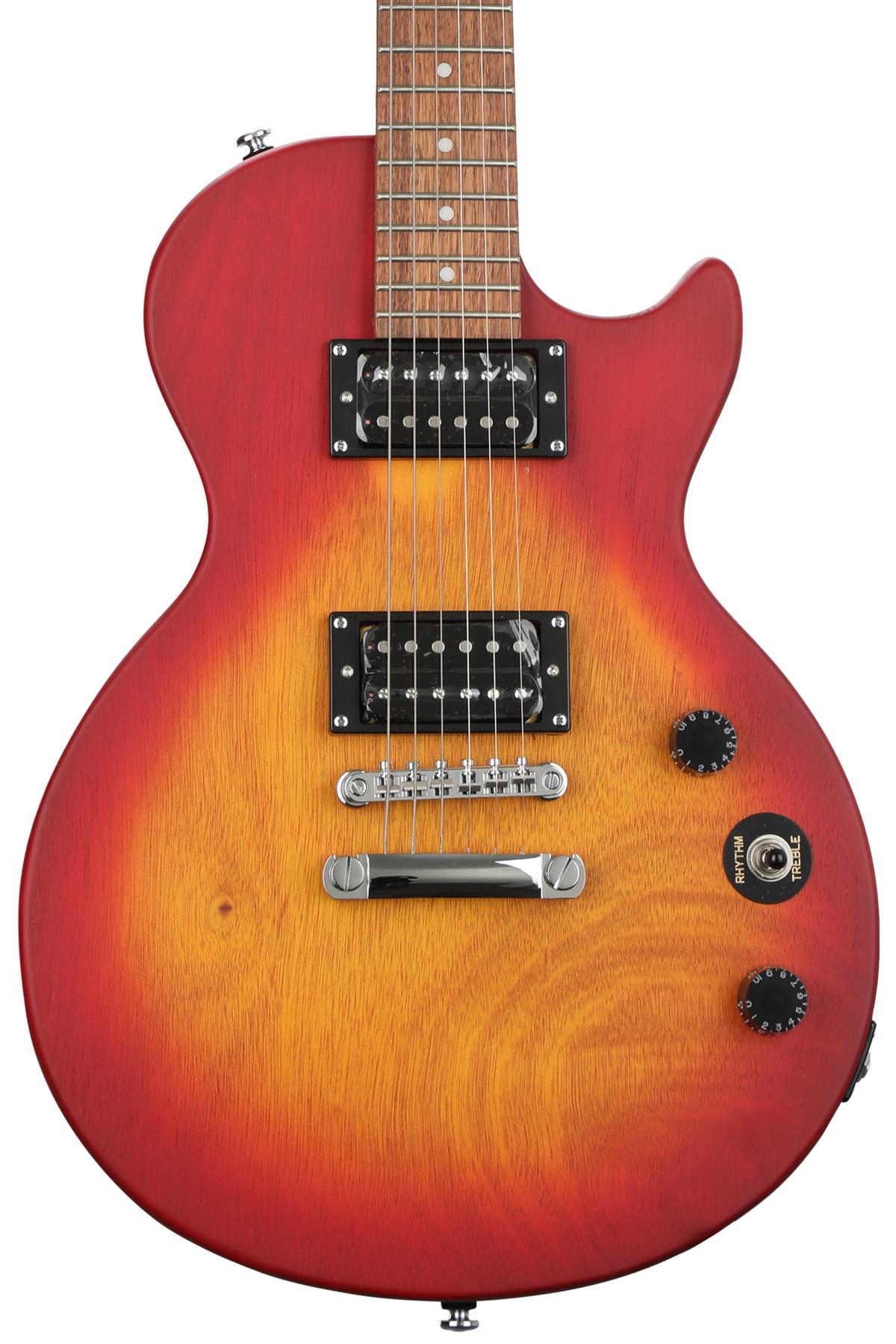
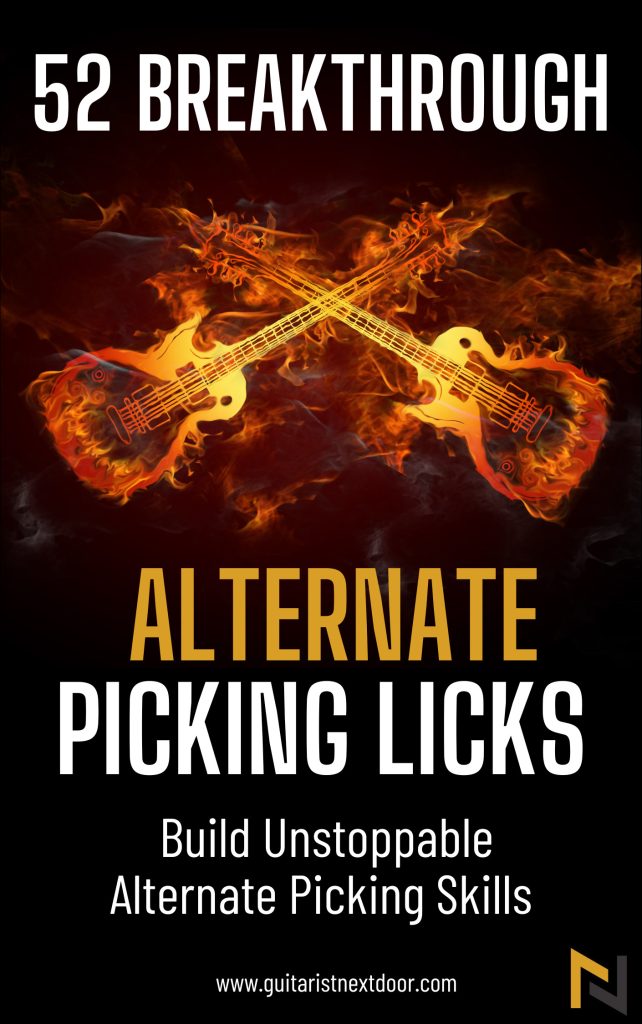





Not going to lie, that Classic Vibe 50s Tele plays better than some Fenders. For me, there is something in spending a little more to get a G&L ASAT Classic. However, that defeats the $500 point in this list. So, I’m totally with the CV50s Tele as the #1 choice.
Both Classic Vibe 50s Strat and Tele are excellent options IMO.
For metalheads, I want to pont out Schecter Omen Extreme-6. In the US, you can still get it for under $500. It’s amazing for that price, but it doesn’t have a floyd rose like the Jackson JS32 Dinky mentioned above. Back in the day I wrote a little review of the Omen: https://guitaristnextdoor.com/schecter-omen-extreme-6-review/
So, obviously, this post has a bunch of models from super popular guitar brands, but I’m curious: does anyone have any guitars from a lesser-known or boutique brand under $500 that they love?